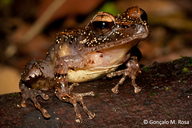|
Description
M 36-43 mm, F 41-47 mm. Tibiotarsal articulation reaches at least the nostril but often reaches beyond snout tip. Hand without webbing, foot webbing 1(1), 2i(1), 2e(0), 3i(1), 3e(0), 4i/e (1-2), 5(0). Dorsal skin smooth but with distinct and continuous inner and outer dorsolateral ridges. Small supraocular spines and distinct heel spines. Dorsal colouration usually light brown or reddish brown, uniform or with a few smaller black markings. However, colour morphs with orange flanks or other patterns can also occur. Males with blackish paired subgular sacs, and with small but visible femoral glands.
Similar species: G. sculpturatus has less melodious notes in advertisement calls and often less distinct femoral glands, whereas G. plicifer has a strongly different advertisement call, is larger, and has large and prominent femoral glands. Distribution and Habitat
Country distribution from AmphibiaWeb's database: Madagascar
Ambanizana, Ambolokopatrika corridor, Besariaka, Chaines Anosyennes, Folohy, forest near Andranofotsy, Foulpointe, Kianjavato, Marojejy, Nosy Boraha, Nosy Mangabe, Tsararano.
It occurs from sea level up to 700m (Vences and Glaw 2008). Life History, Abundance, Activity, and Special Behaviors
Habits: A common species in low-altitude rainforest. Can also occur in forest rudiments or secondary forest. During the day, often seen on the forest floor, where it can perform wide jumps and blends with the leaf litter. At night, males call from leaves 1-2 m above the ground. Calling males do not aggregate in choruses and do not seem to call close to water, indicating that this species may have direct development.
Calls: A loud series of up to 21 short, melodious notes.
Trends and Threats
This species is listed as least concern in view of its wide distribution, presumed large population, and because it is unlikely to be declining fast enough to qualify for listing in a more threatened category. Though it occurs in many protected areas, its forest habitat is receding due to subsistence agriculture, timber extraction, charcoal manufacture, and invasive spread of eucalyptus, livestock grazing and expanding human settlements (Vences and Glaw 2008). Possible reasons for amphibian decline General habitat alteration and loss
Habitat modification from deforestation, or logging related activities
Intensified agriculture or grazing
Urbanization
Comments
Taken with permission from Glaw and Vences (2007).
References
Glaw, F., and Vences, M. (2007). Field Guide to the Amphibians and Reptiles of Madagascar. Third Edition. Vences and Glaw Verlag, Köln.
Vences, M. and Glaw, F. (2008). Gephyromantis luteus. In: IUCN 2008. 2008 IUCN Red List of Threatened Species. www.iucnredlist.org. Downloaded on 18 March 2009.
Originally submitted by: Miguel Vences and Frank Glaw (first posted 2000-11-27)
Edited by: Catherine Aguilar (2009-04-07)Species Account Citation: AmphibiaWeb 2009 Gephyromantis luteus <https://amphibiaweb.org/species/4610> University of California, Berkeley, CA, USA. Accessed May 22, 2025.
Feedback or comments about this page.
Citation: AmphibiaWeb. 2025. <https://amphibiaweb.org> University of California, Berkeley, CA, USA. Accessed 22 May 2025.
AmphibiaWeb's policy on data use.
|
